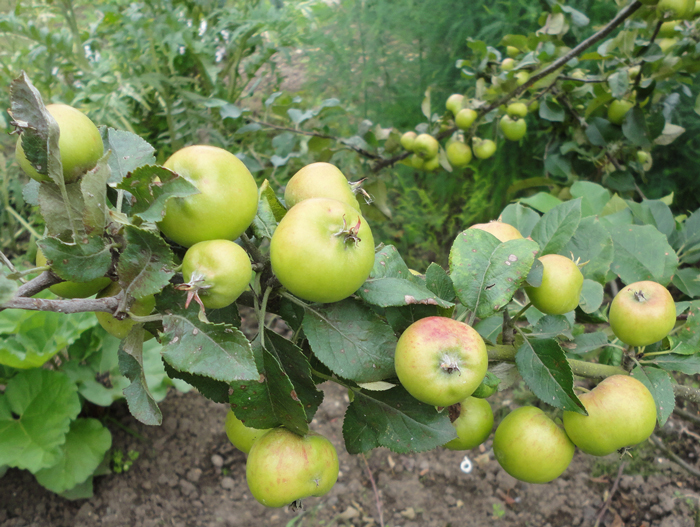June Garden Diary
Our June garden diary is brought to you by Geoff Hodge, the Scotts Miracle-Gro Company.
It’s early summer and you should now be seeing the results of all the work done earlier in the year. So it’s time to really enjoy using your garden. But there are still some essential jobs that need carrying out if the summer is going to be a brilliant and colourful success.
FLOWER BEDS & BORDERS
This is the time to plant out all your bedding and other half-hardy summer-flowering plants – as soon as the fear of severe frosts and cold nights has passed. For best results and colourful displays, prepare the soil well first and add some bulky organic matter, such as home-made compost or planting compost. Adding a controlled-release plant food to the soil at planting time will feed your plants all summer long.
Water the plants in their containers well before planting out, and water them in well afterwards to ensure they establish quickly and grow away. It always pays to plant bedding displays fairly densely to ensure your garden is a riot of colour throughout summer. Most bedding should be planted between 15-25cm (6-10in) apart, depending on their ultimate size.
Cut back the old leaves of spring-flowering perennials, such as Doronicum and Pulmonaria, to encourage a fresh flush of new, healthy and more attractive foliage. This will also keep the plants more compact.
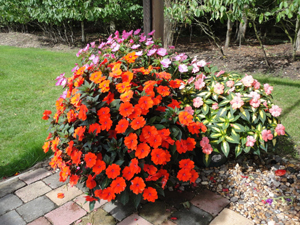 Also remove the old and often diseased leaves of hellebores. Spreading and trailing plants, such as Alyssum and Aubrieta, can become straggly and patchy as they get older. Trim them back after flowering to encourage strong, healthy growth and a better shape. Always give any plants that are cut back a good feed with a liquid plant food to ensure they produce lots of good new growth.
Also remove the old and often diseased leaves of hellebores. Spreading and trailing plants, such as Alyssum and Aubrieta, can become straggly and patchy as they get older. Trim them back after flowering to encourage strong, healthy growth and a better shape. Always give any plants that are cut back a good feed with a liquid plant food to ensure they produce lots of good new growth.
Tall and floppy herbaceous plants – especially those in windy and exposed gardens – will need some support to prevent damage to their flowering stems. Putting plant supports in place now will help prevent problems later on when it’s difficult or impossible to do anything about it. Also, the plants will grow up and through them, covering them discreetly. Then carefully tie in the stems as they develop with soft string or similar, criss-crossing the strings between the supports.
Topical tip
Tie in sweet peas as they grow to ensure they don’t flop and break their stems. Pick sweet peas regularly or flowering may start to slow down or even stop. Regular liquid feeding will help ensure a profusion of blooms throughout summer.
PATIO GARDENING
Create colourful and dramatic patios and other areas by planting up lots of containers, tubs and hanging baskets with summer bedding and patio plants.
Make sure you use plenty of plants, so that the containers look fairly full from the start. This way you’ll get a much better, more colourful display. To sustain such large numbers of plants, it’s essential to use a top quality potting compost.
When planting containers, use taller plants for height, trailers around the edge and fill in with bushy plants. If you’re using mesh-sided hanging baskets, make sure you put plants through the sides too to help hide the basket and produce an even fuller, more colourful effect.
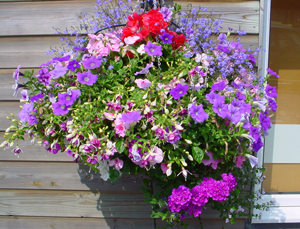 To ensure all containers provide a brilliant display to be proud of, add a controlled-release plant food and water-retention granules to the compost, if they’re not already part of the compost make-up. The food will help feed the plants all summer long, and the gel will prevent the compost drying out prematurely, act as a water reservoir for plants and so help ensure strong, healthy growth.
To ensure all containers provide a brilliant display to be proud of, add a controlled-release plant food and water-retention granules to the compost, if they’re not already part of the compost make-up. The food will help feed the plants all summer long, and the gel will prevent the compost drying out prematurely, act as a water reservoir for plants and so help ensure strong, healthy growth.
Vine weevil larvae are devastating pests of container plants – eating their roots. Watering an approved vine weevil killer onto the compost will help control them.
Topical tip
Check that hanging basket brackets will hold the weight of a fully watered basket, as they can be incredibly heavy. Use self-lowering brackets to make watering easier or install an automatic drip watering system.
LAWNS
A fabulous, lush green lawn makes the rest of the garden look great and sets off all your summer plants. A poor lawn, on the other hand, has the opposite effect.
Mowing weekly as the grass grows is important to maintain the look, as well as ensure the grass grows thickly, which helps keep weeds at bay. Regular mowing is also quicker and easier compared to leaving the grass until it’s so long that the cuttings box fills up and you need to empty it after just a few passes.
The grass will need feeding throughout summer. Whenever there are periods of prolonged dry weather, a liquid lawn feed will be a better choice compared to a granular one.
By now, dandelions, clover, daisies and other lawn weeds may be spreading through the lawn if you haven’t been looking after it properly. The best way to get rid of them at this time of year is to use a lawn weedkiller. You can either apply a lawn feed and weed or, for severe weed outbreaks, spray them with a liquid lawn weedkiller.
Topical tip
Cut uneven lawn edges with a half-moon edging iron set against a wooden board to ensure they look straight, neat and well shaped.
GROW YOUR OWN
Vegetables
Continue to make little and often, successional sowings of all salad and quick-maturing crops to ensure a constant and regular supply throughout the summer. In hot, sunny weather, leafy salad crops may do better when sown in partially shady sites, as these conditions can lead to bitter-tasting leaves.
Lettuce seed is best sown in the cool of the evening rather than during the heat of the day – you’ll get much better germination that way.
Now’s the time to plant out tomato plants, once the first truss of flowers has set. You can grow them in soil in beds and borders, but it’s usually better to use 25-30cm (10-12in) pots filled with a good potting compost or giant planters. And don’t forget you’ll need to regularly water, feed and support the plants as the summer progresses. This is particularly true for plants in containers and planters.
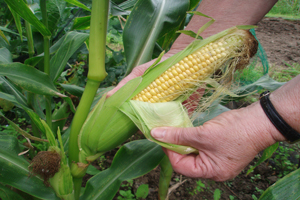 You can also plant out aubergines, peppers, cucumbers, courgettes, pumpkins and other tender vegetables that were sown and grown indoors. All fruiting vegetables tend to crop better when their roots are slightly restricted, so growing them in pots is the perfect answer for bumper crops. Plant some up for the patio.
You can also plant out aubergines, peppers, cucumbers, courgettes, pumpkins and other tender vegetables that were sown and grown indoors. All fruiting vegetables tend to crop better when their roots are slightly restricted, so growing them in pots is the perfect answer for bumper crops. Plant some up for the patio.
Sweet corn is a firm favourite for growing at home, since it tastes especially sweet when freshly picked and eaten straight away. Seeds can be sown outside now or young plants planted out. Sweetcorn is best grown in blocks with plants spaced 45cm (18in) apart, rather than in rows, to improve pollination of the cobs and so ensure a bumper crop.
Topical tip
Pinch out the top 10cm (4in) of broad bean plants once the first beans start to form. This will ensure an earlier harvest and may give some degree of defence against blackfly.
Fruit
During dry weather, make sure that fruit trees and bushes – especially newly planted ones – are well watered. This is especially important while they’re flowering and setting fruit. A 5-7.5cm (2-3in) deep mulch of organic matter or bark will help retain soil moisture, as well as keep weeds down.
Strawberries need a bit of pampering this month if you want good crops of juicy fruit. Water regularly – especially plants growing in containers – and feed weekly with a high potash liquid plant food.
Watch out for slugs and birds, which love the fruit as much as we do. The easiest way to deter birds is to cover the plants with small mesh netting.
Put straw around strawberry plants growing in the ground to prevent soil splashing on to the fruit and spoiling it. Strawberries grown through black plastic don’t need strawing.
Apples, and other tree fruit, that set large amounts of fruit undergo a natural thinning-out this month that sheds excess small fruit; this is called the ‘June drop’. So, don’t panic if you see small fruit lying on the ground.
After most of the smaller apples have dropped off naturally, go round the tree and pick off any diseased or damaged fruitlets and reduce the numbers further if necessary, so there are no more than two apples per cluster.
Reducing the number of plums that have set per branch is also a good idea, as an extra large crop can weigh down branches to such an extent that they snap. Support heavily-laden branches by placing a tall pole in the centre of the tree and lead strings down to the overloaded branches or use a V-shaped stick. It’s better to do this now than wait until later and have the branches snap.
Topical tip
Pick rhubarb until the end of the month, then stop to give plants time to build up their strength for next year’s crop. Mulch with well-rotted manure and water during prolonged dry periods.
TREES, SHRUBS, ROSES & CLIMBERS
Although this is still a great time to plant container-grown trees, shrubs, roses, herbaceous plants and fruit, they may need an extra bit of TLC to ensure they establish quickly.
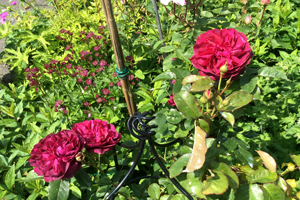 Water the compost in the pot well before planting so that it is thoroughly moist. Plant into well-prepared soil with lots of added organic matter, such as planting compost, with added plant food. Water in thoroughly and water again whenever the weather is hot and dry.
Water the compost in the pot well before planting so that it is thoroughly moist. Plant into well-prepared soil with lots of added organic matter, such as planting compost, with added plant food. Water in thoroughly and water again whenever the weather is hot and dry.
Because rhododendrons, azaleas and camellias set their flower buds for the following year from June to August, it’s vital the soil doesn’t dry out during this time. They are shallow-rooted plants and are very prone to prolonged dry periods. Keep plants thoroughly watered if necessary and mulch the soil. Feeding with a plant food, recommended for acid-loving or ericaceous plants will also help produce good flower bud set to give you a brilliant display next year.
Guide the new shoots of climbers in the direction you need them to grow to provide good, even coverage of their supports. Then carefully tie them in with string or similar soft material. Wherever possible, try to tie in the stems as near to horizontal as possible – or, if more suitable, into a fan shape. This reduces excessive growth of the shoots and, as a result, encourages more flowers.
Topical tip
Deadhead roses regularly as the flowers fade. Just nip off the flower head with thumb and forefinger, rather than cutting off flowered stems with secateurs.
GENERAL GARDENING JOBS
Keep adding annual weeds and the leaves of perennial weeds, lawn clippings and other garden debris, plus uncooked kitchen vegetable waste, to the compost heap. Always mix grass clippings with coarser material otherwise it won’t rot down well. Adding a compost maker or compost activator will help speed up rotting and produce better compost.
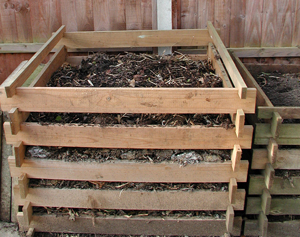 Slugs and snails can still be a major problem at this time of the year. Make sure you check susceptible plants – especially hostas, delphiniums, vegetables and any newly planted young plants. Sprinkle slug pellets around susceptible plants, protect them with suitable barriers or water on a liquid slug killer.
Slugs and snails can still be a major problem at this time of the year. Make sure you check susceptible plants – especially hostas, delphiniums, vegetables and any newly planted young plants. Sprinkle slug pellets around susceptible plants, protect them with suitable barriers or water on a liquid slug killer.
Pests and diseases will be very active this month. Check plants regularly and keep on top of any problems that do occur to ensure they don’t get out of control – early eradication is the key to success. Ready-to-use sprays ensure you have something ready to deal with the problems as soon as they are seen.
Topical tip
Ventilate greenhouses and conservatories on hot, sunny days. Temperatures inside can soon soar and shading the glass will help keep temperatures at a bearable level.
HOUSEPLANTS
Many house and conservatory plants, especially orchids, ficus and citrus, don’t like the stuffy summer conditions indoors. Give them a summer holiday, and put them outside on the patio, sheltered from strong winds and very strong sunshine. Remember to water and feed them throughout the summer – and bring them back inside in the autumn before the onset of cold weather.
Clean shiny-leaved houseplants with a damp cloth or sponge to remove dust and other deposits. This makes them look more attractive and also helps them breathe.
At this time of year houseplant pests are particularly active and can quickly get out of control. Regularly inspect plants particularly for aphids, mealybug, red spider mite, scale insects, vine weevil and whitefly. If you find these pests, control them and help protect your plants from further attack by spraying with an approved systemic insecticide.
Topical tip
Mist foliage houseplants daily to help improve humidity levels and prevent leaf tips turning brown. Or stand the pots on trays filled with moist hydroleca.
Use plant protection products & biocides safely. Always read the label and product information before use. Pay attention to the risk indications and follow the safety precautions on the label.
For full information on all Scotts Miracle-Gro products, visit lovethegarden.com

